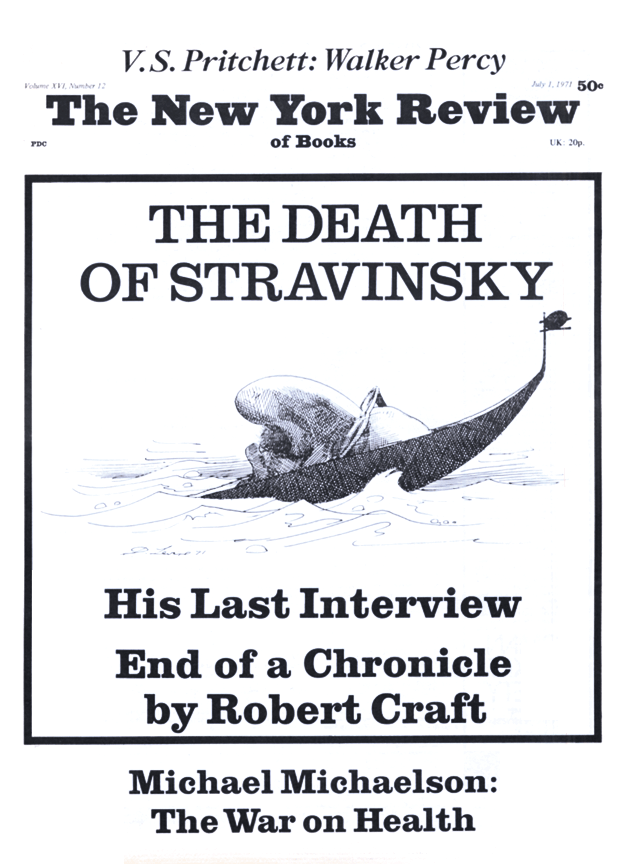In response to:
A Very Difficult Author from the April 8, 1971 issue
To the Editors:
In his generally fine essay on Gertrude Stein [NYR, April 8], Virgil Thomson brings up a few points on which I wish to comment. To get one thing out of the way, the title Tender Buttons, of course, refers to a woman’s nipples. Since he was so explicit in his reminiscences on other matters in Gertrude Stein’s personal affairs, I wonder why he didn’t explain this minor point since he questioned the idea.
In the listing of titles at the beginning of the article, three named are not easily available as they are out of print (the Trans-Atlantic interview, the Sprigge and the Sutherland studies). However, two recent books on Gertrude Stein (G.S. & the Literature of the Modern Consciousness by Norman Weinstein and The Development of Abstractionism in the Writings of G.S. by Michael Hoffman) are available and make considerable comment on the Tender Buttons interpretation. Although Thomson does not say so, Tender Buttons is in print in a very unattractive but useful edition by Haskel House as well as in the Modern Library Selected Writings.
In discussing interpretations of Tender Buttons, Thomson might have added Hoffman’s view that the book is a series of “still lifes” in which by design she produces a work of sustained abstractionism. The obvious parallel is to the cubist art developing during the same period. This seems to me as good an explanation as I have seen or can myself invent. Weinstein calls Tender Buttons a “mirror for our nonsense, a dictionary for our daily distraction….” It’s possible. As long ago as 1949, Roselind Miller in “Gertrude Stein: Form and Intelligibility” called Tender Buttons’s words “multiordinal,” depending on the context, on various levels of abstraction the words have different meanings. Miss Miller concludes that even though the combinations are “strange,” nevertheless, the “reader’s explication proves far more rewarding than an ordinary verbal picture.”
After years of exposure to Gertrude Stein’s writing, I can only suggest that the student approach the text of her creative work thus: read again again again then aloud aloud aloud again love love love. You either get it or you don’t. I like to think I did.
Paul Padgette
San Francisco, California
Virgil Thomson replies:
I wonder if nipples (male or female) is really quite so obvious a reading.
1) There is another erogenous zone in female anatomy that could just as easily be called a tender button.
2) Either meaning taken alone, since it bears no clear relation to the book, comes closer I think to straight pornography than was Miss Stein’s taste or custom.
3) And what if Tender Buttons were a bilingual pun from the French tendres boutons, the early buddings of a tree or plant? In that case it would mean that the writings included were a new development like the eclosion of leaf, flower, or branch. And whatever erectile suggestiveness may go along with this would imply that we are in the presence of a natural force moving toward explosion. Indeed there is evidence that Gertrude Stein so viewed the writings in this book.
4) She also viewed them as related to cubist painting, itself an explosive force of some magnitude. But neither her statements to that effect nor Mr. Padgette’s agreement with her can explain how this relation came about. The visual and the verbal do not normally run parallel. And whatever consanguinities of method and approach that were involved must surely be matched by ineluctable oppositions between painting, a space art, and literature, a time art. Not to mention the differing mental processes involved in their imagination and perception.
Terms like “sustained abstractionism,” moreover, scarcely help. For neither the cubists nor Gertrude Stein thought of their work as “abstract.” Guillaume Apollinaire’s term for what they were doing was “super-realism” (surréalisme he called it). And if their simplifications occasionally approached incomprehensibility, this aim was less urgent to them than opening up reality (both of the object and of the perceiving mind) for getting an inside view. That such a view, however opposed to common sense, was true and convincing was early proved by the eagerness of monied viewers to acquire cubist pictures and the delight with which readers of Tender Buttons would quote line after line of it from memory.
This Issue
July 1, 1971


